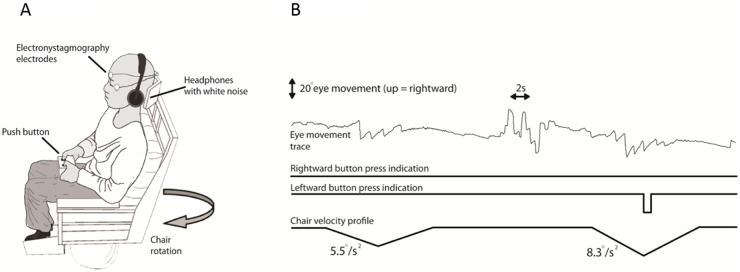Figure 1.
Vestibular thresholds. Apparatus and methods. (A) Participants sat on a computer-controlled rotating chair (earth-vertical axis). Horizontal eye movements were recorded with electro-nystagmography. Participants indicated their perceived direction of motion by pressing a button to indicate leftward or rightward motion. White noise was delivered through earphones. (B) Raw traces for two subsequent rotations for Patient 08. The top trace shows the electro-nystagmography signal. The middle and bottom traces show the patient’s button press to indicate perceived motion direction, right and left. In this example, the chair rotated from rest to the left, at constant acceleration. The chair continues to accelerate until a correct button response is made or if 5 s has elapsed without a correct button press, or no button press, as here. As no response was made during the test period over 5 s, the chair underwent a controlled deceleration to a stop over 5 s. The second rotation, here also to the left (the rotation directions are randomized), was of increased angular acceleration as determined by the Modified Binary Search (MOBS) algorithm (Tyrrell and Owens, 1988; see Supplementary material for further details). In general, for a given direction (left versus right), a non-perceived rotation is followed by a rotation of higher acceleration, while a perceived rotation is followed by a lower acceleration rotation. Further detail on how the test terminates, and hence thresholds obtained for left and right rotations, can be found in the Supplementary material.

